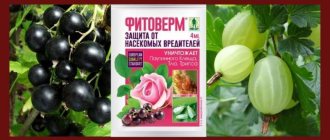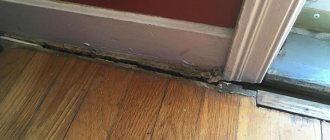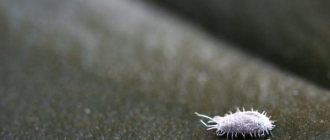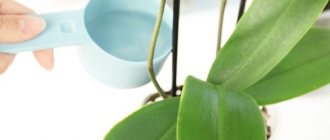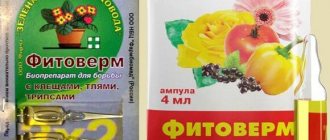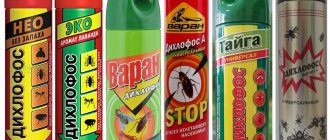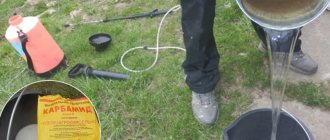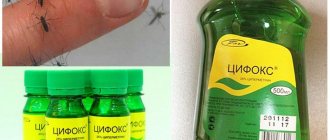What is it and what is it used for
Concentrated emulsion, has a wide spectrum of action, used to combat ticks and insects. Sold in packages of 2 and 4 ml (glass or plastic ampoule), 20 and 50 ml (bottle), 5 l (canister). Has a strong chemical smell. The color of the emulsion is yellowish. Effective against:
- ticks,
- aphids,
- caterpillars,
- thrips,
- scale insects,
- whiteflies,
- Podurov,
- leaf roller,
- Colorado potato beetle,
- paths,
- worms.
Mechanisms of action:
- Contact . The insect dies from contact of its surface with the product after 3-5 days.
- Intestinal . The toxic substance penetrates the parasite’s stomach, and after 10 hours paralysis of the digestive system occurs. As a result, the insect dies.
The effect after treatment lasts up to 14 days. Thus, if the procedure is carried out twice, the orchid will be protected for a month.
Advice! If a plant is heavily infested with scale insects or mealybugs, the best result will be obtained not by Fitoverm, but by a systemic chemical insecticide.
Insects that gnaw on parts of the orchid will die within 2-3 days. The sucking pests will die in 5-6 days.
Speed of impact on the pest
6 hours after application, the gnawing insects stop feeding and do not move at all for some time. Then they die. As for sucking pests, the effect of the drug can last up to 12 hours. After this time, the insects no longer feed, but die after a few days.
It will take you about a week to completely get rid of parasites. In this case, the leaves will remain fatal to them for another 3 weeks.
How to determine the presence of parasites
Inspect leaves on both sides and their axils, flowers and buds. The orchid is taken out of the pot, particles of the substrate are carefully removed, and the roots are washed in lukewarm water.
Advice! Sometimes it can be difficult to detect insects in the substrate. They use a trick: place a piece of cucumber or apple on the surface of the soil overnight. The next morning they check whether the parasite crawled onto the treat or not.
The healthy color of the root system is greenish-pearly - before watering, green - after it. The roots are thick, elastic, smooth. If black, brown, brown spots, soft slimy areas, or yellowing are found, it means that the orchid is sick.
The damaged areas are cut off with a sharp sterile instrument, the sections are sprinkled with cinnamon and crushed activated carbon. If signs of pests are detected in the soil, the plant is transplanted into a new substrate.
Nuances of use
Fitoverm is a powerful drug for killing pests on orchids. To achieve the best effect, you need to use it:
- at air temperatures above +20 degrees;
- on dry days, when the humidity is low and no rain is expected;
- in the evening, before it gets dark.
If the infection is severe, you can increase the toxin content in the solution. But then you will have to be more careful when processing. Avermectins are not harmful to plants; they are not able to penetrate cell membranes.
"Fitoverm": pest control
Treatment is carried out at any time of the year, in the morning. Ultraviolet light decomposes the drug. Apply the method of watering or spraying. Depending on the degree of infestation of the orchid and the type of pest, different dosages and treatment methods are used. Be sure to wipe the area where the pot with the infected flower was located.
Advice! Flower growers recommend dipping the orchid upside down in the Fitoverma solution. Leave for 1 hour. Wipe the leaf axils with a dry cloth.
Mealybug
It feeds on orchid juice. Hides on the back of leaves, in the axils, and soil. An adult reaches 5 mm. Balls that look like a piece of dirty white cotton wool appear on the orchid. Before treatment with an insecticide, parasites visible to the eye are mechanically removed using tweezers and a cotton swab. Then the roots of the plant are washed with Fitoverm. The orchid is transplanted into fresh soil, which should also be treated. To avoid the appearance of insects in the future, wipe the leaves with Fitoverma solution every 5 days.
Scale insects and false scale insects
Measuring 2 mm, the pest settles on leaves, stems, and pseudobulbs. In the process of life, it secretes a sticky substance on which the sooty fungus settles. As the parasite spreads throughout the orchid, the leaves turn yellow and fall off. The female lays up to 2000 eggs during her life. White dots and cobwebs are signs of a pest.
Using tweezers, carefully remove parasites from the plant. The orchid is sprayed with Fitoverm 2 times at weekly intervals. The roots are washed in a solution of the drug, the soil is changed. The pot is washed and doused with boiling water.
Ticks
To destroy the root mite, the orchid is taken out of the flowerpot, pieces of the substrate are taken out from the roots, then washed in warm water. Dead parts are removed, watered with Fitoverm, and the sections are sterilized. The plant is planted in new soil and a washed pot. The treatment is repeated twice at weekly intervals.
To combat spider mites and false spider mites, the orchid is sprayed with the prepared Fitoverma solution three times, with an interval of 5 days. During treatment, high air humidity is maintained in the room with the plant.
Sciarides
These fungus gnats settle in the upper layers of waterlogged soil. Getting rid of them is simple: lower the air humidity. If larvae are found in the soil, it is changed. The use of Fitoverm in this case is not necessary. However, if desired and for preventive purposes, fresh soil is watered with a solution of the drug.
Fools
The size of the insect is 0.2 mm - 1 cm. The color is white, grayish or with a greenish tint. Parasites are not dangerous for the orchid, but are an indicator of improper care of the plant. 2 ml of the drug are diluted in 50 ml of water. The orchid is watered.
Whiteflies
Pests similar to white flies can appear on the orchid. Larvae and adults feed on flower sap. They parasitize on the back of the leaf, in the soil, under the bark. As the parasites multiply, the orchid leaves turn yellow and curl into a tube.
The orchid is washed with soapy water and treated with Fitoverm. Maintain optimal humidity levels.
Thrips
Pests that are nocturnal. They settle in the ground, sucking root juices. Color black, size – up to 2.5 mm. There are two pairs of wings. Their presence is indicated by dark spots on the leaves. Conditions for appearance are low air humidity and high temperature.
Advice! Place a container with wet expanded clay next to the orchid pot. This ensures constant air humidification near the plant.
The orchid is given a warm shower, paying attention to the axils and the underside of the leaves. Next, spray with Fitoverm.
Fruit midges
They settle in waterlogged substrates. If reddish midges, 1-2 mm in size, are detected, reduce watering of the orchid. If larvae are found in the substrate, it is changed or watered with Fitoverm. The drug is also used for prevention purposes.
Aphid
As a result of its vital activity, it forms a sticky substance that is attractive to ants and fungi. The leaves turn black, curl and fall off.
Before treating with an insecticide, remove the damaged parts of the flower. The orchid is washed with soapy water. Then chemicals are used.
What kind of drug is this?
This drug is an insecticide that can cope with more than 20 types of pests.
Orchids are often affected by various pests and the drug Fitoverm is indispensable for them.
A simple and easy-to-use biological product that easily fights the most difficult to eradicate and widespread pests such as:
- thrips;
- aphid;
- spider mites and many others.
They can easily treat plants at home. Moreover, it is very convenient for home use due to the fact that it has no odor.
This is a fairly strong remedy that instantly kills insects . It does not cause environmental pollution and disintegrates very quickly in water or soil.
Composition, rules of breeding and use
The active ingredient “Fitoverma” is aversectin , concentration 2 g/liter. The biological product is produced on the basis of soil microorganisms and is therefore safe.
The orchid is processed on the balcony. Children and pets, as well as other indoor plants and an aquarium with fish should not be in the room. A container should be used that is not subsequently used for food.
Note! Treatment is carried out with a freshly prepared solution. The drug cannot be stored. Effectiveness lasts up to 8 hours in a place protected from light.
During the treatment process you should not eat, drink or smoke. At the end, wash your face and hands thoroughly with soap and water and rinse your throat.
Important! The drug has a hazard class of 3. This means that it is only dangerous if ingested. However, when working, they strictly follow the instructions and use personal protective equipment - a mask and gloves. Contact of the product with the skin and mucous membranes may cause allergies. The drug is stored out of the reach of children and pets.
Preparation depends on the type of parasite being treated:
- Aphids, whiteflies, thrips, duras. Dissolve 2 ml of the drug in a glass of water.
- Spider mites: 2 ml per liter of water.
Note! The temperature of the water used to prepare the solution should be 15-300C.
Before treatment with Fitoverm, insects are mechanically removed from the orchid - with sterile tweezers, a damp swab, or a cotton swab. Next, the plant is given a warm shower, left to drain, and the necessary processing measures are carried out.
Note! The plant is sprayed with the drug. Watering alone cannot be used, since Fitoverm is not a systemic drug, that is, it is not absorbed by the root system.
Spraying
Produced in the morning, with protection from sunlight - the drug quickly decomposes in the light. The leaves are treated - on both sides, the trunk, peduncle and bulbs - as necessary.
Watering
Produced in the morning, if insects were found in the substrate, using the immersion method. Leave for 5-10 minutes, leave to drain and return to its permanent place. Or the orchid is watered with a solution instead of water.
After treatment, the orchid is left without soil for a week, placed in a plastic bag for a day. Then the orchid is placed in a container without soil. Place separately from other plants. The roots are sprayed with water daily. Inspections are carried out periodically. If signs of infection are visible after a week, repeat treatment. If there are no signs, for the purpose of prevention, the orchid is sprayed with Fitoverm.
If leaves are damaged, gardeners recommend wiping the leaves with a cotton pad soaked in the preparation at least 4 times a day for 10 days.
Store the drug in a place inaccessible to children, at a temperature of -20 - +300C, for up to 2 years.
Pros and cons of the drug
Plants treated with phytoverm quickly return to normal and get rid of pests. It's all about using a truly effective drug. Fitoverm has many advantages over similar compositions:
- decomposes completely within 24 hours after contact with the stems and leaves of the plant, as well as the substrate;
- do not be afraid to dilute and then apply the product if fruits are ripening on your indoor plants - the chemical concentrate will not affect them;
- already 2 days after the elimination of insects on domestic plants, you can eat their fruits, if any;
- The drug has shown its effectiveness more than once, and pests do not adapt to it. The effect of insects becoming accustomed to phytoverm will definitely not affect you.
There are many points that can negatively affect the quality of the solution:
- if you are treating plants outdoors, rain or dew can significantly reduce the effect;
- it is necessary to re-apply the preparation to the flowers, otherwise you are unlikely to be able to completely remove the insects;
- It is quite possible that you will need adjuvants - special components that can somewhat reduce the surface tension of water. Thanks to their use, fitoverm is much easier to distribute over the leaves of an indoor flower;
- In no case should you add other poisons to the fitoverm;
- high cost is another significant disadvantage of the drug.
Despite its shortcomings, the product has gained wide popularity among gardeners, since with its help you can get rid of pests quite effectively.
Advantages and disadvantages
The drug has a number of advantages and disadvantages. Pros :
- Low level of toxicity.
- Pests do not get used to the product when used periodically.
- Economical consumption compared to analogues.
- Does not accumulate in the external environment, quickly disintegrates. When watering the soil, the drug will completely disintegrate within a day, on the leaves - after 3 hours.
- Highly effective at the initial stage of infection.
- Can be used at high temperatures and during orchid flowering.
- Quick effect.
- Does not affect the growth and flowering of orchids.
Minuses:
- Low efficiency when there is a strong spread of pests.
- Does not destroy parasite eggs.
- Repeated treatment is required to completely get rid of insects.
- It does not linger on the foliage, so the product is mixed with soap.
- High cost compared to analogues.
- You cannot combine treatment with Fitoverm and other drugs.
- It is dangerous for aquatic organisms, so the remaining solution should not be poured into the sink.
- Not safe for bees.
Note! Orchid flowers cannot be treated. If parasites are found on them, they need to be torn off.
Expert advice on using Fitoverm for processing orchids
Regarding the use of Fitoverm to protect orchids from pests, some experts express an opinion that makes sense to listen to:
“On my orchids I use exclusively the original Fitoverm from Pharmbiomed, marked “M”. Of course, it is more expensive, but unlike the usual drug, Fitoverm M is modified - a good adhesive is added to it. When sprayed, it rolls down the leaves less, and this is very important for effective treatment with a non-systemic drug. “Fitoverma” from other brands in this sense are inferior to the original one.”
S. Ryzhkova, florist with 15 years of experience
Pest prevention
Proper care of your orchid will protect it from pests. Rules :
- Optimal watering. Is individual for each plant. An indicator that it is time to water the plant is the silvery color of the roots. A useful technique is used: a wooden stick is placed in the soil. If it is dry when removed from the substrate, the orchid is watered. If there are midges in the soil, the plant is watered.
- When purchasing a new orchid, place it separately from other indoor plants for a month. If no signs of diseases or pests are found, the pot is moved to the right place.
Advice! For preventive purposes, the newly acquired plant is watered and sprayed with Fitoverm. Take 2 ml of the drug per 1 liter of water. Next, the orchid is left in a draft-free room. After an hour, the leaf axils are wiped with a dry cloth.
- Leaves, buds, flowers, roots are periodically inspected. If signs of insects are detected, the orchid is isolated and treatment begins.
- The air around the orchid must be humidified. Thrips like dry environments.
- Scale insects like excess nitrogen in the soil and settle on weakened plants. Fertilize the plant only when necessary, following the instructions.
- When making soil yourself, its elements are calcined in the oven at 1500C for 5-10 minutes and boiled. You can buy a ready-made substrate or its elements at a flower shop.
- The orchid pot is chosen to be transparent, with smooth walls. This way the gardener will be able to observe the roots, notice the presence of diseases or pests in time and begin treatment.
Precautionary measures
Fitoverm is a natural drug, but this does not mean that you can forget about precautions. There are several recommendations that must be followed:
- to dilute the product, choose a container that you will not use in the kitchen (wash dishes or vegetables in it);
- after completing the procedure, wash your hands thoroughly with soap or some detergent;
- Either throw away the poison container after treating the plants, or wash it and leave it in the pantry or some inaccessible place for the next treatment of indoor flowers.
Follow the key rules, and you will not only be able to achieve good results, but also not cause harm to yourself or your indoor flowers.

